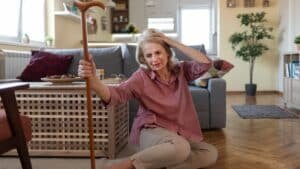
Falls are a real risk for those of us over 60. Recently, Ivana Trump died from a fall at home.
According to a 2018 Centers for Disease Control report, 35.6 million falls occurred among those 65 and older. These resulted in injuries for 8.4 million of the cases and 32,000 deaths.
These numbers can be reduced if older adults take action to cut their risks. Usually, fall prevention centers on external changes. That’s the “outer” game which includes things like making modifications around the house. There’s also an equally important “inner game” for fall prevention.
External Changes
Examples of external changes to prevent falls include:
- Put in grab bars around the home, particularly in bathrooms.
- Remove loose rugs and install non-slip materials under other carpets and rugs.
- Add more lighting.
- Make sure transitions between spaces don’t risk tripping.
An excellent resource for renovating your house to prevent falls can be found in AARP’s publication, HomeFit Guide.
Considering the Inner Game
Awareness is the centerpiece of the inner game of fall prevention. Cultivating an ongoing vigilance about fall risk during your day-to-day activities can make a big difference in keeping you safe.
The inner game consists of some simple principles.
Physical Fitness
Maintaining muscle strength and flexibility by walking and similar exercise will assist in preventing falls. It’s easier to keep your balance when your overall fitness is better.
Also, keeping that extra weight off is essential since it can aggravate many medical ailments that lead to falls.
Seek Help if Lightheaded or Dizzy
Dizziness and imbalance often lead to falls. Medical conditions like diabetes or heart ailments can be causes. Also, general age-related deterioration of inner-ear function can cause this as well. Seek medical advice at the first signs of these symptoms as they may indicate more significant issues.
Side effects of medications can also contribute to dizziness and imbalance. In any case, medical help could prevent falls.
Footwear Matters
The wrong footwear could lead to falls. For example, wearing slippery socks or slippers at home could be harmful. Also, ensure your footwear is comfortably snug to improve balance and avoid tripping hazards.
Regular Vision and Hearing Check-Ups
Balance depends on the interaction between the inner ear, the sense of touch and vision. Make sure to schedule regular vision and hearing tests. Also, take time to adjust to new glasses or contacts.
Let There Be Light
A well-lit environment will prevent falls. Turn on lights when moving around the house, especially at night. Add lighting in dim areas.
Falls and Alcohol
About 65% of fatal falls are related to alcohol use. If you are a bit unsteady already, alcohol will make the risk of a fall much worse.
Go Slow
Standing up too quickly can sometimes result in imbalance. Take your time standing up, rising from a chair or getting out of bed to ensure you feel steady on your feet.
Canes and Walkers
To many, using a cane or walker signifies extreme old age. Yet, the risk of not using such supports when needed opens the door to the worse alternative of falling and getting hurt. Swallow your pride and consult an occupational or physical therapist to fit and train you on proper use.
Slippery When Wet (or Icy)
If a surface seems wet or icy, assume that it is. A supply of sand or salt by the door is handy for applying to dangerous ground. Also, footwear is available with ice-gripping studs to make walking to the mailbox in winter much safer.
Stair Risk
Stairways pose a high risk for falls. Adding handrails and non-slip surfaces is a necessity. Also, get in the habit of being deliberate by planning each stair walk. Focus on each step up or down. Carrying items up or down stairs increases the risk. Instead, use a tote bag for carrying things while holding the handrail. Finally, make sure the stairway is well-lit to avoid disaster because of missing a step on a dark staircase.
Improving your inner game of fall prevention takes focus and practice. However, if you know your limits and increase your fall awareness, following these simple principles will help reduce your risks.
Are you afraid of a fall? Have you experienced a fall or know someone who has? Did your (their) confidence drop dramatically after a fall? What changes in your environment have you made to make it easier to navigate?





